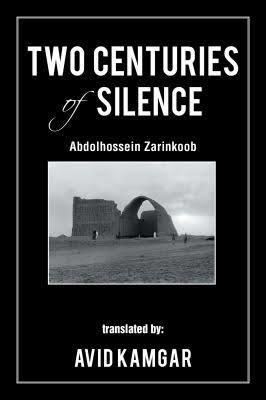8.8 /10 1 Votes
Publication date 1957 | 4.4/5 Goodreads Publisher Amirkabir Pub., Tehran Originally published 1957 | |||||||||||||||||||||||||||||||||
 | ||||||||||||||||||||||||||||||||||
Original title دو قرن سکوتDo Qarn Sokūt Similar كتاب فارسنامه, The Remaining Signs of, Futuh al‑Buldan, The epic of kings, History of the Iranian Constituti | ||||||||||||||||||||||||||||||||||
Two Centuries of Silence (Persian: دو قرن سکوت Do Qarn Sokūt) is a book written by Abdolhossein Zarrinkoub, a prominent scholar of Iranian culture, history and literature. The work is a historical account of the events and circumstances of the first two centuries of Islam in Persia (modern day Iran) following the Islamic conquest of Persia in the 7th century AD. The history covers the events from the invasion of the Arabs to the rise of the Tahirid Dynasty.
Contents
- Do gharn sokout part 1
- Feud in the Light of Knowledge
- Similarities between Islam and Zoroastrianism
- References
Zarrinkoub presents a lengthy discussion on the large flux and influence of the Arabs on the literature, language, culture and society of Persia during the two centuries following the Islamic conquest of Iran. Zarrinkoub discusses how the Arab/Islamic conquest was followed by almost "two centuries of silence" socially, culturally and politically by native Persians.
In the preface to the second edition of his book, in 1957, Zarinkoob writes, “I picked up my pen and crossed out what was dubious, dark, and incorrect in the first edition. Many such instances were occasions that in the past―either due to immaturity or by prejudice―I had been unable to rightly acknowledge the faults, iniquities, and defeats of Iran." "Now, did I do my duty properly in this revision? I do not know, and I am still of the opinion that the moment a history writer chooses a topic, he has strayed from neutrality."
Do gharn sokout part 1
Feud in the Light of Knowledge
In this singularly fascinating chapter, Zarinkoob speaks of the battles that transpired between Iranian mobeds (Zoroastrian priests) and Muslim Arab theologians, in the light of knowledge and wisdom. In Caliph Ma'mūn’s debate gatherings, a fight took place about religions and philosophy, among the people of book, in which physical force and sword played no role. Theologians and scholars, familiar with Greek, Iranian, and Hindu educations, argued with experts in Islamic traditions, on topics such as, whether or not human beings have a will of their own, and whether the Quran is created or not.
In the Pahlavi book, Shekand Gumanic Vichar (Doubt-Dispelling Exposition), which was apparently written shortly after Ma'mūn’s era, there are remarks that disclose the extent of the mobeds’ bewilderment. For example in one place the Quran states, “I, myself, draw humans to deviance, that if I so desire I can bring them to the righteous path, but I want them to go to Hell.” Then in a different place it declares, “Humans are themselves the cause of sin and the doers of evil. . .” Such is the example of what the Mazdayasnans were articulating in their struggle against the Islamic ulama, and in their attempt to prove the supremacy of their religion. However, the tongue of the Muslim orators―like the sword of their ghazi―triumphed in rebuffing these doubts and objections, and ended all such conversations.
Similarities between Islam and Zoroastrianism
Accepting Islam for the majority of Iranians was not difficult, as Islam had many of the Zartoshti attributes. For, although Ahura Mazda and Ahriman were not identical to Allah and Iblis, and angels in the heavens had metamorphosed, their lasting images had endured, and beyond these outward transformations, they continued to seem familiar and recognizable to Iranians. Heaven, Hell, Judgment Day, and As-Sirāt (the hair-narrow bridge that according to Islam, every person must pass on the Day of Judgment, ) were also reminiscent of one or another ancient belief, such as Dūzakh (Hell) and the Chinvat Bridge. Even the five daily-prayers had already been recommended in the Zartoshti faith.
Furthermore, dualism entered Islamic belief through Qadariyah that was one the first Islamic philosophical schools. Qadariyah core belief was that human beings were in control of their actions and should not assign their deeds to God’s will. It was based on separation of the sources of good and evil; and thus incompatible with Islam’s wahdat (oneness). This notion was issued, at the end of the Umayyad era, by Ma'bad Juhāni (d. 699), who had adopted the views of an Iranian by the name Sanbuya.
